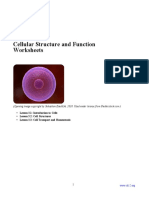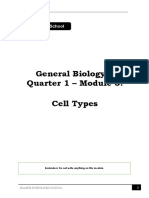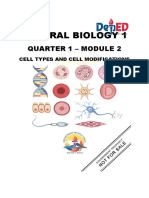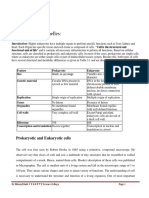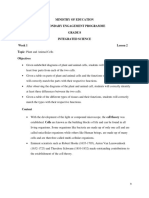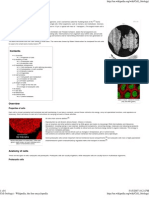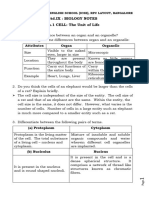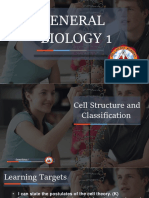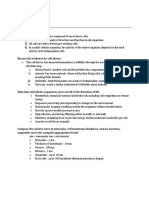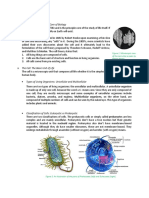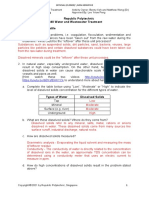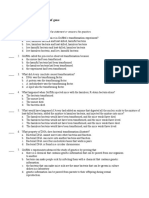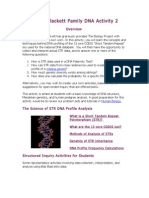AY 2020 Sem 1 A104 P01 WS Team 2
AY 2020 Sem 1 A104 P01 WS Team 2
Uploaded by
Lim Liang XuanCopyright:
Available Formats
AY 2020 Sem 1 A104 P01 WS Team 2
AY 2020 Sem 1 A104 P01 WS Team 2
Uploaded by
Lim Liang XuanCopyright
Available Formats
Share this document
Did you find this document useful?
Is this content inappropriate?
Copyright:
Available Formats
AY 2020 Sem 1 A104 P01 WS Team 2
AY 2020 Sem 1 A104 P01 WS Team 2
Uploaded by
Lim Liang XuanCopyright:
Available Formats
A104 Biology
Problem 1: Blocks of Life?
Student resources [Access March 2020]:
1. Factsheet and history of the Cell Theory:
Lauren Royal-Woods. The wacky history of cell theory (Video)
http://ed.ted.com/lessons/the-wacky-history-of-cell-theory
2. Basics of Cell:
What is a cell? Scitable by Nature education (Video)
http://www.nature.com/scitable/topicpage/what-is-a-cell-14023083
3. James A. Sullivan. Comparison between cell types (animation)
http://www.cellsalive.com/cells/cell_model.htm
4. Glossary
Copyright © 2020 by Republic Polytechnic, Singapore
1. There are 2 major classifications of cells, as seen in the figure below:
*Archaea was only recently discovered
Cells and constitutes a highly specialized
group of prokaryotes that
characteristically live in extreme
environments. For more information on
Eukaryotic cells the history of its discovery, check out
Prokaryotic cells this link [Access March 2020]:
Eg. Plants, Animals Eg. Bacteria, Archaea* http://www.ucmp.berkeley.edu/
archaea/archaea.html
Figure 1 illustrates the cellular structures of a Eukaryotic and Prokaryotic cells.
Figure 1: Eukaryotic vs Prokaryotic Cells
Referring to Figure 1, compare the differences between a Eukaryotic cell and a Prokaryotic
cell. List the differences in the table below [Access March 2020]:
Video: https://www.youtube.com/watch?v=RQ-SMCmWB1s
Copyright © 2020 by Republic Polytechnic, Singapore
Characteristics Eukaryotic cell Prokaryotic cell
Cell wall Present in plant cells but not in Present
animal cells
Nucleus Membrane bound nucleus nucleus is absent
DNA (genetic material) Present in all cells Present in all cells
Cell membrane Present Present
Organelles Contains organelles Lack organelles
Exist in Single-Cellular or Single-Cellular and Multicellular Single-Cellular
Multi-Cellular form?
Example of types of cells fungus bacteria
2. If we were to examine humans, animals and plants under a microscope, we would view its cells,
shown in the figures below.
Figure 2a: Human cheek cells Figure 2b: Cells in dog's blood Figure 2c: Plant cells
Observe the cells’ structures. What are some similarities and differences that you notice
between animal, human and plant cells? List out these differences.
Similarities:
Vacuoles
Lysosome
Cell membrane
Ribosomes
Cytoplasm
Differences:
Copyright © 2020 by Republic Polytechnic, Singapore
Unlike plant cells, human and animal cells do not have cell wall
Unlike blood cells, the plant cells and human cell have nucleus
Unlike plant cells, human and animal cells does not have chloroplast
3. Animal and plant cells are eukaryotic cells but have important differences. Refer to Figure 3
and identify parts A to D. Explain their functions.
Figure 3
Structure Name of Function Found in Plant
structure or Animal Cell?
A Cell wall It helps in the maintenance of the cell Plant
structure and shape.
B Chloroplast It helps to absorb sunlight and use it in Plant
conjunction with water and carbon dioxide
gas to produce food for the plant.
C Nucleus It controls cell activities such as cell growth Plant
and the repair of worn-out parts. It is also
essential for cell division.
D Vacuole It is the storage structure in a cell. It can hold Both
food for later use or waste for removal.
*Fun Fact: Mitochondria and chloroplasts in eukaryotic cells bear a striking physical appearance. Explore
the evolution of these organelles [Access March 2020]:
http://www.sumanasinc.com/webcontent/animations/content/organelles.html
Copyright © 2020 by Republic Polytechnic, Singapore
4. In summary, eukaryotic and prokaryotic cells consist of different types of structures which
enable the cell to function accordingly. Hence, organelle structures give rise to cellular
function.
Watch the YouTube video on animal cells [Access March 2020]:
https://www.youtube.com/watch?v=g4L_QO4WKtM
a. Describe the structure of cellular membrane and explain how it creates the cell’s
complexity. List the advantages of this.
Cellular membranes form a barrier between cytoplasm and the outsides of the cell to
help regulate and control what goes in and out of the cell. It helps organize a group of cells
to form an organelle which allow for greater efficiency and become more specialized
b. Identify the cellular structures/organelles containing a membrane. List the organelle’s
functions in the table below.
Name of structure Function
containing membrane
Cell Membrane responsible for transport of ions, nutrients and waste across the
membrane
Nucleus Control cellular activities, stores DNA, production of ribosomes
Endoplasmic Reticulum Contains, modifies and transports proteins. Generates New
membrane and neutralize toxins
Golgi apparatus Modifies,sorts and packages and distributes protein.
Mitochondria Energy Production
Vesicles transportation of molecules between different location of the cell.
Lysosomes Digestion of cell components and molecules
Vacuoles Membrane-bound cavity containing liquid,food molecules or
cellular secretionsVesicles
5. The Modern Cell Theory states that:
1) All known living things are made up of one or more cells
2) All living cells arise from pre-existing cells by division.
3) The cell is the fundamentals unit of structure and function in all living organisms.
4) The activity of an organism depends on the total activity of independent cells.
5) Energy flow (metabolism and biochemistry) occurs within cells.
6) Cells contain DNA, the blueprint for their cell growth, development and behavior and is
found in the nucleus. It also contains RNA which could be found in the cell nucleus and
cytoplasm.
Copyright © 2020 by Republic Polytechnic, Singapore
7) All cells are basically the same in chemical composition in organisms of similar
species.
*http://www.saylor.org/site/wp-content/uploads/2010/11/Wiki-Cell-Theory.pdf [Access March 2020]
Using the cell theory stated above, compare and contrast between the types of cells discussed
so far, and identify if they fulfill the all the requirements of the cell theory:
Cell Theory Is this true for Is this true for Is this true for
animals? Elaborate plants? prokaryotes (e.g
where appropriate. Elaborate bacteria)? Elaborate
where where appropriate.
appropriate.
1) All known living Yes Yes Yes, prokaryotes is a
things are made up of unicellular organism
one or more cells.
2) All living cells arise Yes Yes Yes
from pre-existing cells
by division.
3) The cell is the Yes Yes Yes
fundamental unit of
structure and function
in all living
organisms.
4) The activity of an Yes Yes No.Prokaryotes is a
organism depends on unicellular organism
the total activity of and does not depend
independent cells. on the total activity of
independent cells.
5) Energy flow Yes Yes Yes
(metabolism and bioc
hemistry) occurs
within cells.
6) Cells contains yes yes Yes
DNA which is found All cell have DNA,cell
specifically in the membrane cytoplasm
chromosome and and ribosomes
RNA found in the cell
nucleus and
cytoplasm.
7) All cells are Yes Yes Yes
basically the same in
chemical composition
in organisms of
similar species.
Copyright © 2020 by Republic Polytechnic, Singapore
6. Based on the Cell Theory and on your understanding of the cell structure and function,
explain how cells are “self-regulating”. Give examples.
Self-regulation is an important factor in cell division and differentiation as it helps to
maintain and sustain the shape and activities within the cells. For example, in mammals,
after part of the liver has been removed, the remaining part regenerates automatically
compensating for the loss. Another example, the self-assembly of cellular organelles from
biologic macromole-cules.
7. Going further:
With the knowledge of the cell structure and function, it is possible to engineer and alter the
functions of basic cells. Two examples are given below:
A. Production of human medicine in mass quantities such as insulin using bacteria.
B. Crops such as corn can be altered to be resistance to herbicides, making it easier to kill
weeds without affecting the corn.
Based on what you have learnt about cell structure and function, explain how cellular
engineering is possible? What are some potential problems arise from this technology?
Cellular engineering is possible as we use mathematics, physics, engineering and
computer science to understand and model how cells regulate and optimize their shape and
function in response to specific stimuli, and aim at building automated machines out of living
cells. One of the problems that can arise from this technology is it can cause foreseeable
damage to the ecosystem. Example will be overusing herbicides can drive weed and the
increased use of glyphosate resistant crops could lead to increase in human health problems.
Another example is that it can lead to disease transmission in the human body where some
diseases such as cancer,blood disorders and genetic conditions may be present.
End of Worksheet
Copyright © 2020 by Republic Polytechnic, Singapore
You might also like
- Cell Biology Illustrated ReportDocument21 pagesCell Biology Illustrated ReportIlze Krauze100% (11)
- Knowledge From 33rd DegreeDocument3 pagesKnowledge From 33rd DegreeCarlos V89% (9)
- ANSWERS Worksheets Cell Structure FunctionsDocument24 pagesANSWERS Worksheets Cell Structure FunctionsAnghel LopezNo ratings yet
- 03 Genome Chromosome and Dna Webquest 2Document4 pages03 Genome Chromosome and Dna Webquest 2api-31377933760% (5)
- Biology Syllabus NotesDocument14 pagesBiology Syllabus NotesSana SyedNo ratings yet
- Embryo Development SEDocument7 pagesEmbryo Development SEWWE FightsNo ratings yet
- A104 Biology Problem 1: Blocks of Life? Student Resources (Access March 2020) : 1. Factsheet and History of The Cell TheoryDocument6 pagesA104 Biology Problem 1: Blocks of Life? Student Resources (Access March 2020) : 1. Factsheet and History of The Cell Theoryjaswanth sriramNo ratings yet
- Prok A Ryo Tic Eukaryotic CellsDocument31 pagesProk A Ryo Tic Eukaryotic CellsAMADO JR BANAWANo ratings yet
- Chapter 2.2 Two Types of CellsDocument25 pagesChapter 2.2 Two Types of CellsRACHEL SINDHUNo ratings yet
- Gen Bio 1 Module 4Document13 pagesGen Bio 1 Module 4Ante,Glainry Rose Basan100% (1)
- 2425 Level M Biology Course Questions Solutions (Level L)Document130 pages2425 Level M Biology Course Questions Solutions (Level L)nmoukarrabNo ratings yet
- Grade 8 Integrated Science Week 1 Lesson 2Document4 pagesGrade 8 Integrated Science Week 1 Lesson 2purityayigaNo ratings yet
- Week 1 cb1131 NotesDocument24 pagesWeek 1 cb1131 NotesTanisha ChowdharyNo ratings yet
- Neil Hubilla - Gen Bio 1 q1 Las 3Document5 pagesNeil Hubilla - Gen Bio 1 q1 Las 3Neil Jhon HubillaNo ratings yet
- Delhi Public School, Bangalore - East Biology Notes Cell:Structure and FunctionDocument4 pagesDelhi Public School, Bangalore - East Biology Notes Cell:Structure and FunctionSaket TNo ratings yet
- General Biology 1 Module 2 Q1Document17 pagesGeneral Biology 1 Module 2 Q1Pril Gueta83% (12)
- General Biology 1 Quarter 1 Week 2.1: CapsletDocument7 pagesGeneral Biology 1 Quarter 1 Week 2.1: CapsletAmil, Shierly Mae S. -10 QUISUMBINGNo ratings yet
- Gen. Bio 1 Module 2Document6 pagesGen. Bio 1 Module 2Evelyn MagbarilNo ratings yet
- BiologyDocument15 pagesBiologyChit su su zawNo ratings yet
- تخدير المحاضرة الاولىDocument7 pagesتخدير المحاضرة الاولىXcv FfgNo ratings yet
- Science & TechnologyDocument115 pagesScience & TechnologyvinayNo ratings yet
- Cell and Cell OrganellesDocument53 pagesCell and Cell OrganellesShiffa SaheedNo ratings yet
- Cell Structure and Functions PDFDocument92 pagesCell Structure and Functions PDFAishaizl100% (1)
- Plant and Animal CellsDocument4 pagesPlant and Animal Cellseasylearning83No ratings yet
- Biology Worksheet Activity 2 The CellDocument9 pagesBiology Worksheet Activity 2 The CellAaron Lance LopezNo ratings yet
- Genbiology1 - Com3 - Day5Document10 pagesGenbiology1 - Com3 - Day5Blossom Mae TorresNo ratings yet
- Unit 1 - 3Document32 pagesUnit 1 - 3Sunita SharmaNo ratings yet
- Lesson 2: Cell Types and Cell ModificationDocument14 pagesLesson 2: Cell Types and Cell ModificationMariz GenandaNo ratings yet
- General Biology q1 w2 Mod2Document40 pagesGeneral Biology q1 w2 Mod2Karen Mae Castillo100% (1)
- Cell (Biology) - Wikipedia, The Free EncyclopediaDocument6 pagesCell (Biology) - Wikipedia, The Free Encyclopediaapi-3714451100% (2)
- Chapter 1b - CellDocument49 pagesChapter 1b - CellKw ChanNo ratings yet
- General Biology 1: Modified Strategic Intervention MaterialsDocument58 pagesGeneral Biology 1: Modified Strategic Intervention MaterialsKurt DimacaliNo ratings yet
- Intro2 - Different Types of CellsDocument22 pagesIntro2 - Different Types of CellsCheryl MountainclearNo ratings yet
- General Biology Module 2Document11 pagesGeneral Biology Module 2Jee-Anne Herbulario100% (1)
- Prokaryotic Vs Eukaryotic 1Document39 pagesProkaryotic Vs Eukaryotic 1Luke kenneth MacalawaNo ratings yet
- Ln.1 Cell - NotesDocument7 pagesLn.1 Cell - Noteshiteshseema2008No ratings yet
- Gen Bio 1 Lesson 1.1 Cell Structure and ClassificationDocument47 pagesGen Bio 1 Lesson 1.1 Cell Structure and ClassificationZander Ezekiell FernandezNo ratings yet
- Biochemistry Lecture 1Document16 pagesBiochemistry Lecture 1azraawsNo ratings yet
- Chapter 1 - Cell Structure and OrganellesDocument48 pagesChapter 1 - Cell Structure and OrganellesNatalie GraceNo ratings yet
- PRESTON HOLT - Cells Investigation LEXILE 610Document6 pagesPRESTON HOLT - Cells Investigation LEXILE 610Brian HoltNo ratings yet
- The Cell Is The Smallest Functional Unit of LifeDocument54 pagesThe Cell Is The Smallest Functional Unit of Lifesoccerforever009No ratings yet
- 1 Sep 2023 - Lecture 01 - Introduction - Biologi Sel 2023Document61 pages1 Sep 2023 - Lecture 01 - Introduction - Biologi Sel 2023kiki ariansyahNo ratings yet
- BIOENERGETICSDocument8 pagesBIOENERGETICSSarah Calventas100% (1)
- Module 5 EALSDocument9 pagesModule 5 EALSKleffer YnanNo ratings yet
- 2.1 Cell Theory: Topic 2: CellsDocument11 pages2.1 Cell Theory: Topic 2: CellsMorgan LockeNo ratings yet
- 2.3: Prokaryotic and Eukaryotic Cells: Two Types of CellsDocument3 pages2.3: Prokaryotic and Eukaryotic Cells: Two Types of CellsJubaer UtshobNo ratings yet
- Prokaryotic and Eukaryotic CellsDocument7 pagesProkaryotic and Eukaryotic Cellsjodeoiraluis josonNo ratings yet
- Lecture 2 BIO201Document31 pagesLecture 2 BIO201Madiha Abu Saied Tazul Islam 1721217No ratings yet
- The Science of Cytology Cell Theory: The Principle Core of BiologyDocument6 pagesThe Science of Cytology Cell Theory: The Principle Core of Biologyhendrix obciana100% (1)
- LESSON 1 Biochem Lecture 1Document37 pagesLESSON 1 Biochem Lecture 1wmaximoff426No ratings yet
- S4en Biology Chapter 1Document59 pagesS4en Biology Chapter 1MeharNo ratings yet
- An Overview of Cell Biology: August 2015Document31 pagesAn Overview of Cell Biology: August 2015Quennie Rose EderNo ratings yet
- Biology Chapter 1 NotesDocument6 pagesBiology Chapter 1 Notesmohan.shenoy52No ratings yet
- Sallim Herniza P. Week 1 General Biology 1 SW1Document8 pagesSallim Herniza P. Week 1 General Biology 1 SW1Nurhaliza KuhutanNo ratings yet
- Biom1070 L1 2022Document34 pagesBiom1070 L1 2022Kevin ZhangNo ratings yet
- Science7 PlantandanimalcellsDocument20 pagesScience7 PlantandanimalcellsMyra FongNo ratings yet
- Lecture 2 BIO201Document30 pagesLecture 2 BIO201raihan10012004No ratings yet
- PRPLLLDocument19 pagesPRPLLLPraveen KolaganiNo ratings yet
- Untitled PresentationDocument43 pagesUntitled Presentationtagudjameslervy.cte.cpcNo ratings yet
- IB Biology Notes - 23 Eukaryotic CellsDocument3 pagesIB Biology Notes - 23 Eukaryotic CellsJohn Philip D. NapalNo ratings yet
- Cell BiologyDocument9 pagesCell BiologyMick HardyNo ratings yet
- The Animal Cell and Division Biology for Kids | Children's Biology BooksFrom EverandThe Animal Cell and Division Biology for Kids | Children's Biology BooksNo ratings yet
- B001 L04 Is SlidesDocument42 pagesB001 L04 Is SlidesLim Liang XuanNo ratings yet
- AY 2022 Sem 2 A107 L01 Lecture Notes (Lecturer)Document53 pagesAY 2022 Sem 2 A107 L01 Lecture Notes (Lecturer)Lim Liang XuanNo ratings yet
- AY 2022 Sem 2 A107 Physics Module Slides (Students)Document24 pagesAY 2022 Sem 2 A107 Physics Module Slides (Students)Lim Liang XuanNo ratings yet
- FYP Report Template - RP - SAS (JX)Document24 pagesFYP Report Template - RP - SAS (JX)Lim Liang XuanNo ratings yet
- General SAS Laboratory Safety Awareness For Student AY2021Document48 pagesGeneral SAS Laboratory Safety Awareness For Student AY2021Lim Liang XuanNo ratings yet
- B001 L02 WorkbookDocument4 pagesB001 L02 WorkbookLim Liang XuanNo ratings yet
- Thomson East Coast Line 3 BrochureDocument19 pagesThomson East Coast Line 3 BrochureLim Liang XuanNo ratings yet
- Connect Student Briefing A221Document34 pagesConnect Student Briefing A221Lim Liang XuanNo ratings yet
- Eat To Survive: A208 - Ecology and Earth ScienceDocument25 pagesEat To Survive: A208 - Ecology and Earth ScienceLim Liang XuanNo ratings yet
- Republic: PolytechnicDocument3 pagesRepublic: PolytechnicLim Liang XuanNo ratings yet
- AY 2122 Sem 1 A334 P04 PracticeQuestionsDocument3 pagesAY 2122 Sem 1 A334 P04 PracticeQuestionsLim Liang XuanNo ratings yet
- AY 2020 Sem 2 A221 Module Story (For Student) UpdatedDocument22 pagesAY 2020 Sem 2 A221 Module Story (For Student) UpdatedLim Liang XuanNo ratings yet
- Instruc - PolyMall Login and Possible ErrorsDocument6 pagesInstruc - PolyMall Login and Possible ErrorsLim Liang XuanNo ratings yet
- Introduction To A319 Environmental Data AnalysisDocument18 pagesIntroduction To A319 Environmental Data AnalysisLim Liang XuanNo ratings yet
- Environmental Management The Roleof Remote Sensing and GISIn The Built EnvironmentDocument15 pagesEnvironmental Management The Roleof Remote Sensing and GISIn The Built EnvironmentLim Liang XuanNo ratings yet
- AY 2021 Sem 1 A308 P03 Individual AssignmentDocument3 pagesAY 2021 Sem 1 A308 P03 Individual AssignmentLim Liang XuanNo ratings yet
- AY 2019 Sem 2 A114 ESEDocument30 pagesAY 2019 Sem 2 A114 ESELim Liang XuanNo ratings yet
- Republic Polytechnic A348 Water and Wastewater Treatment Worksheet 6: Dirt in KettleDocument9 pagesRepublic Polytechnic A348 Water and Wastewater Treatment Worksheet 6: Dirt in KettleLim Liang XuanNo ratings yet
- AY 2021 Sem 2 A309 P11 Instructions For E-LearningDocument7 pagesAY 2021 Sem 2 A309 P11 Instructions For E-LearningLim Liang XuanNo ratings yet
- Team 3's Presentation: Members: Liang Xuan, Yi Ling, Earlwin, AnanthDocument5 pagesTeam 3's Presentation: Members: Liang Xuan, Yi Ling, Earlwin, AnanthLim Liang XuanNo ratings yet
- Republic Polytechnic A348 Water and Wastewater Treatment Worksheet 7: How To "Soft" This Problem?Document10 pagesRepublic Polytechnic A348 Water and Wastewater Treatment Worksheet 7: How To "Soft" This Problem?Lim Liang XuanNo ratings yet
- G121 - AY20S2 - CA3 - Student Instructions - 20201117Document4 pagesG121 - AY20S2 - CA3 - Student Instructions - 20201117Lim Liang XuanNo ratings yet
- Genetic Diversity of Mycobacterium TuberculosisDocument10 pagesGenetic Diversity of Mycobacterium TuberculosisDavid LomentigarNo ratings yet
- Karyotyping ActivityDocument1 pageKaryotyping Activityjadenj891No ratings yet
- 12.1 Identifying The Substance of Gene-2Document5 pages12.1 Identifying The Substance of Gene-2MING ZHUNo ratings yet
- Rates of Dark CO2 Fixation Are Driven by Microbial Biomass in A Temperate Forest SoilDocument58 pagesRates of Dark CO2 Fixation Are Driven by Microbial Biomass in A Temperate Forest SoilIsais NNo ratings yet
- Darwin EvolutionDocument20 pagesDarwin EvolutionSajjad AliNo ratings yet
- Botany - Section A: AIIMS Level Test (27-Mar) Part SyllabusDocument25 pagesBotany - Section A: AIIMS Level Test (27-Mar) Part SyllabusThe BoNg FOOD recipesNo ratings yet
- Blackett Family DNA Activity 2Document22 pagesBlackett Family DNA Activity 2Mit TurkiNo ratings yet
- Basics of Scientific Writing, Scientific Research, and Elementary Data AnalysisDocument12 pagesBasics of Scientific Writing, Scientific Research, and Elementary Data Analysisburhan sabirNo ratings yet
- GenetikDocument5 pagesGenetikRaffi MariezkiNo ratings yet
- CGS Cross Sheets WillistoniDocument2 pagesCGS Cross Sheets WillistoniMathew WebsterNo ratings yet
- Boundless Biology Study Guides - 1702859293714Document9 pagesBoundless Biology Study Guides - 1702859293714Kayizzi SilverNo ratings yet
- Exercise Anole EvolutionDocument4 pagesExercise Anole EvolutionDylanNo ratings yet
- General Biology 1: Prepared By: Ms. Louie Jane T. EleccionDocument45 pagesGeneral Biology 1: Prepared By: Ms. Louie Jane T. EleccionKatNo ratings yet
- DNA Microarrays: by Mohammed Mashik Kommareddy Krithik Yadu Krishnan Mubashir Deepak A SDocument30 pagesDNA Microarrays: by Mohammed Mashik Kommareddy Krithik Yadu Krishnan Mubashir Deepak A SVipin GeorgeNo ratings yet
- Cell (Biology) - Wikipedia 5Document1 pageCell (Biology) - Wikipedia 5piping stressNo ratings yet
- Barkow, J. H. (2005) - Missing The RevolutionDocument311 pagesBarkow, J. H. (2005) - Missing The RevolutionJose OlarteNo ratings yet
- 2023 Mottron Gagnon Acta Psychologica New Diagnostic CriteriaDocument11 pages2023 Mottron Gagnon Acta Psychologica New Diagnostic CriteriaMathieu Saint-LaurentNo ratings yet
- UNIT 5 Reading 1 & 2Document8 pagesUNIT 5 Reading 1 & 2민수No ratings yet
- The Epigenetic Basis of Cellular HeterogeneityDocument16 pagesThe Epigenetic Basis of Cellular Heterogeneitylei guNo ratings yet
- Asexual ReproductionDocument31 pagesAsexual ReproductionCool VighneshNo ratings yet
- Earth and Life Module Week 14Document12 pagesEarth and Life Module Week 14Austin Capal Dela CruzNo ratings yet
- Natural Selection and The Co-Evolution of InteractionsDocument85 pagesNatural Selection and The Co-Evolution of InteractionsMusicPlayerNo ratings yet
- The Genetic Basis of Dental Anomalies and Its Relation To OrthodonticsDocument5 pagesThe Genetic Basis of Dental Anomalies and Its Relation To Orthodonticsyuniarita eka putriNo ratings yet
- Defining Spatial StructureDocument12 pagesDefining Spatial StructureYJLNo ratings yet
- General Biology 2: Quarter 3: Module 5Document6 pagesGeneral Biology 2: Quarter 3: Module 5Ann Lorraine Montealto SadoraNo ratings yet
- INJSO BiologyDocument151 pagesINJSO BiologyQuarantine funNo ratings yet


